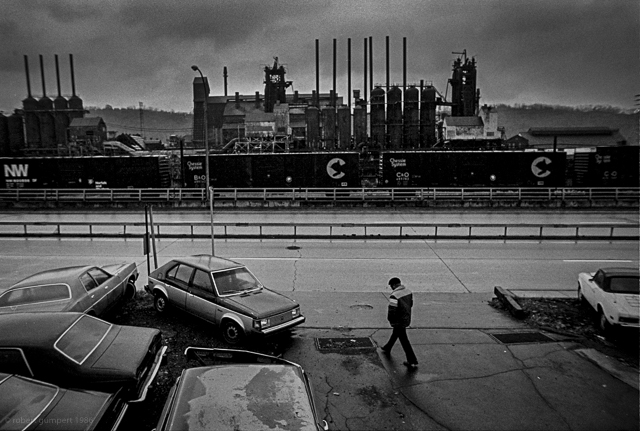Addendum to Early article: The legacy of the Sadlowski campaign was swamped by the tsunami of the 1980s steel industry crisis
By Garrett Brown
Officially, Ed Sadlowski lost the 1977 election for president of the United Steel Workers of America (USWA) by a margin of 43% to 57% to the candidate of the union’s officialdom, Lloyd McBride. Some Sadlowski supporters in his rank and file organization, Steelworkers Fight Back (SFB), believed that he actually won the contest, but voter fraud in Canada (more votes than local union members) led to the electoral loss. The SFB campaign in Canada was simply not strong enough to prevent that kind of fraud, if that’s what happened.
But Canadian irregularities may not have been necessary as the officialdom’s mobilization of its 800 appointed “international staff” to threaten local union officers and members that if they voted for Sadlowski, then the international’s staff at local, regional and national levels would turn its back on the local unions when it came to grievance hearings, local contract bargaining, or other support from the international union, was anything but an idle threat.
The fact that SFB was credited with 43% of a national union election was remarkable in documenting the ferment in the union and the openness to a new, more radical approach by working steelworkers.
But within a few short years this potential was swamped by the collapse of the steel industry, and the inability of the SFB leaders to generate an alternative program to the union officialdom’s complicity with management’s slow-motion suicide.
Coming out of the Second World War, the U.S. steel industry was the industry world leader and steel towns around the country boasted some of the best jobs and most stable, well-resourced working class communities anywhere. Forty-five years later, the industry was in crisis and steel towns were well down the road of ruin and abandoned rubble, a la Bruce Springsteen’s Youngstown.
This happened because the owners and managers of American steel made two big decisions:
1) Instead of continuing the industry’s traditional reinvestment of a percentage of profits into renovation and technology, they opted to follow the siren call of Wall Street’s “go-go 1980s” sending nearly all profits to the “coupon-clipper” shareholders
2) Industry managers stubbornly refused to adopt new, more efficient technologies being installed by Europe’s steelmakers (rebuilding from the ashes of WWII) and new steelmakers like Korea and Brazil. Instead of investing in the basic oxygen process (“BOP shops”) and expanding electric arc furnaces to remelt and reuse recycled steel, the U.S. industry relied for way too long on the century-old open hearth, integrated steel process.
The result was that “foreign competition” ate the U.S. industry’s lunch over several decades, while management paid out millions to stockholders and invested in other industries by way of asset diversification, leaving the mills and steel towns in terminal decline, and gutting the pensions and lives of tens of thousands of steelworkers and their families.
The industry’s answer was the still ongoing campaign (30+ years later) against “unfair foreign competition,” often centered on China and frequently with racial overtones.
With the industry’s self-looting and union officials’ connivance, despite the Sadlowski campaign, USWA members were trapped on the Titanic headed into the iceberg fields. The response of the USWA officialdom – always following the lead of management – was to become the choir in the “church of trade sanctions against unfair foreign competition.”
Unfortunately, the activists of SFB and the Sadlowski campaign were not able to offer an alternative and credible alternative to steelworkers who became increasing desperate to save their jobs and their communities from the catastrophe looming ever larger on the horizon.
Sadlowski himself never again ran for elective office in the USWA – a lost opportunity in my view, but it was his decision to make. Rank and file activists in SFB were not able to follow the example of the long-term organizers of Teamsters for a Democratic Union (TDU) – a development itself worthy of more discussion about why. Steel towns around the country in the 1980s and 1990s became hollowed-out shells where young people had no future, and many left.
Given the many challenges facing the labor left in the 21st century, it is worth thinking about what would have been an accessible, attractive and “feasible” alternative plan to save the U.S. steel industry in the 1980-90s that could have galvanized and inspired the steelworkers who voted for Sadlowski.
Would nationalization of the steel industry – or worker-run cooperatives – or coops run by boards including environmentalists and community members as well as workers – won the hearts and minds of steelworkers and steel towns in the era of President Reagan – or now in the era of President Trump?
How can we turn the unrealized potential of the Sadlowski campaign and legacy of hard-working SFB activists for a democratic, member-run union with radical program into a reality in an economy and labor movement that is so seemingly different from the 1970s? Yet the underlying problems are basically the same.
It is another of the ironies of American labor history that the union and workers that almost elected Ed Sadlowski international president should (40 years later) still be the cheerleaders of trade sanctions against steelworkers in other countries, and, according to USW officials, that voted 40% for a billionaire con-man grifter in the 2016 election.
Garrett Brown wrote extensively about the Sadlowski campaign as a reporter for The Daily Calumet newspaper in South Chicago in 1976-77. He was also a not-so-secret supporter of Steelworkers Fight Back and the election campaign during his free time on nights and weekends.
